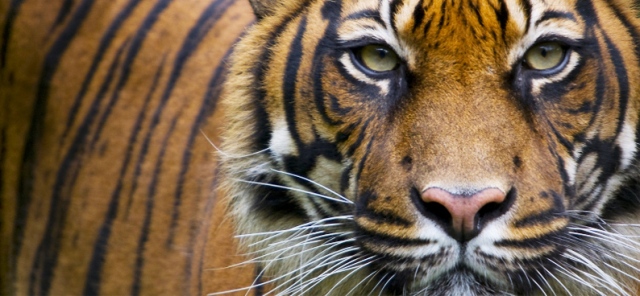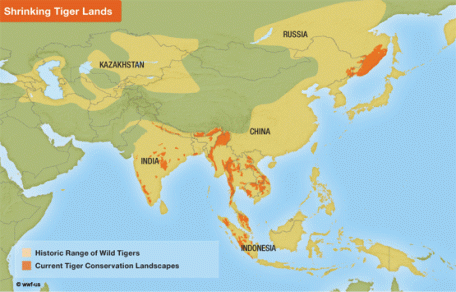
A new population survey in India shows tigers making a modest comeback. Photo credit: WWF.
THE TIGER is an iconic endangered species, with as few as 3,200 left in the forests of India and Southeast Asia. Conservationists have invested millions of dollars into saving the species, and recent population surveys have showed a promising uptick in the number of tigers in the wild.
This is good news for tigers. But is it good news for people living with tigers?
The answer is a mixed bag. Tigers keep forest ecosystems across Asia in balance as the dominant top predator, and sustain ecotourism and conservation funding as a flagship species.
But living in close proximity to tigers can be dangerous.

The historic range of tigers is shown in beige, while the current range is orange. The region is now home to 3 billion people, with tigers occupying the few forests and national parks amidst the growing sprawl. Photo credit: WWF.
Due to the high population density of Southern Asia, tigers are responsible for more human deaths than any other large cat, killing approximately 60 people annually. Deaths are often the case of mistaken identity and occur most frequently on the fringes of tiger habitat, where the large cats have the best chances of crossing paths with humans.
As human populations expand and tiger populations recover, attacks are expected to occur more frequently.
Tiger attacks are a severe form of human-wildlife conflict. Other forms of human-wildlife conflict include livestock predation, harassment, property damage, and interpersonal conflict over wildlife issues.
Human-wildlife conflict isn’t a tiger specific issue. Without proper management, conflict can arise wherever abundant wildlife and expanding human populations overlap. Issues often arise with large predators such as bears, wolves, coyotes, lions, and crocodiles, as well as large and potentially dangerous herbivores such as elephants, hippos, and even deer.

Deer-vehicle collisions, crop raiding elephants, and bears with an appetite for garbage are all potentially deadly examples of human wildlife conflict. Photo credit: Mercury Press.
Such conflicts can destroy livelihoods and undermine conservation efforts.
Thankfully, many innovative solutions have been crafted to address a variety of human-wildlife conflicts and avoid lethal control measures. Some solutions are species specific, while others are broadly applicable.
1. Strobe Lights
To scare off destructive nocturnal wildlife, farmers increasingly rely on automatic light machines. Half strobe light and half motion sensor, the machines flash beams of light randomly in all directions to mimic a farmer with a flashlight. Wary nocturnal animals have been shown to avoid such light signals, although the effect wears off over time as wildlife becomes habituated to the lights.
2. Natural Barriers
To keep elephants at a safe distance from their farms and homes, some African villagers have turned to two unlikely, all-natural solutions: bees and hot peppers. Elephants dislike the chemical capsaicin found in chili peppers, prompting farmers in Tanzania to smother their fences with a mixture of oil and chili peppers. In addition to a spice aversion, elephants are also terrified of bees. This realization has led to the construction of bee fences around farms to keep marauding pachyderms out.

Beehives strategically placed along the length of fences keep elephants out. Photo credit: Elephants and Bees Project.
3. Disguise
Villagers in India have had recent success preventing tiger attacks by exploiting their knowledge of big cat behavior. Tigers stalk their prey and attack from behind, so forest workers began wearing masks on the back of their heads to prevent sneak attacks. Over a 3-year period, no attacks were reported among those wearing masks, while 29 unmasked people in the same region were attacked over 18 months. Unfortunately, the effectiveness of masks decreases over time as tigers become habituated to the disguise.
4. Electricity
Animals don’t like getting shocked any more than you do. To deter wildlife from human dominated areas, conservationists commonly use electricity to create a lasting negative impression. Solar powered electric fences keep crop-raiding elephants out of fields in Africa, while wildlife managers in Alaska use tasers to deter moose and bears that have become habituated to humans. Conservationists in India have even tried to discourage tiger attacks by rigging human shaped dummies with electricity. While a sharp electric zap may sound like an extreme way to deter animals, such methods are highly preferable over lethal control measures.
5. Texting

While the elephants themselves don’t send text, their radio collars containing SMS chips do. Photo credit: Gizmodo.com.
Imagine getting a text message from a wild elephant. In the Western Ghats of India, a new conservation initiative has utilized texting as an early warning system to prevent human-elephant encounters. Elephant tracking collars embedded with SMS chips automatically text nearby residents, warning them of recent elephant movements. Before the project was implemented, a lack of awareness of elephant whereabouts played a roll in 75% of elephant-attributed human deaths in the region. Since the implementation of the early warning system, human deaths have dropped by 50%, with none being reported in 2010 and 2013.
6. Corridors
One way to reduce conflicts with wild animals is by guiding their movements in developed areas. Wildlife corridors, areas of preserved native habitat in human dominated regions, provide wildlife with a safe pathway as they travel between larger areas of intact habitat. By placing corridors away from potential conflict hotspots, such as farms or ranches, animals can be steered out of harms way and instances of human-wildlife conflict can be proactively avoided.
7. Mapping
Using GPS tracking collars and GIS mapping software, researchers can identify hot spots where human-wildlife conflict is likely to occur. These hotspots often coincide with developed regions at the edge of national parks, but the data from tracked animals can reveal individual movement patterns that may be unexpected. Identifying conflict hot spots helps to pinpoint ranger manpower and funding to proactively address the issue of human-wildlife conflict.

13 ‘urban’ brown bears were tracked in Anchorage, Alaska using GPS collars to study instances of human wildlife conflict. Each dot represents a transmission from a collar to a satellite, while each color represents an individual brown bear. Photo credit: Alaska DP&G.
8. Ecotourism
Poverty exacerbates human-wildlife conflict. A rouge animal that destroys an impoverished farmer’s crops essentially destroys their livelihood, so it is not surprising that such conflict can inspire outrage and negative views of conservation efforts. Ecotourism can combat this reaction by assigning a monetary value to wildlife. Ecotourism outfits owned and operated by local communities, rather than corporations, can uplift entire impoverished regions by providing additional job opportunities and a boost for the local economy.
What YOU can do
Most people don’t live alongside tigers, lions, or elephants, but you can still do your part to prevent human-wildlife conflict. By following a few simple guidelines, you can minimize your risk, protect your property, and live safely alongside wildlife.
- Be proactive – Since most animals are naturally afraid of humans, conflicts often arise when animals become habituated to humans or associate them with food. Avoid feeding wild animals, securely store your garbage, and feed pets indoors to avoid attracting unwanted visitors. Fence in your garden, and plant unpalatable vegetation to discourage browsing.
- Be prepared – Before camping, hiking, or venturing into natural areas, learn about the animals that you might encounter. Let others know your plans before venturing off in the woods, and if possible hike with a companion. Above all, don’t approach or harass any wild animals that you encounter, and heed signage warning of potentially dangerous wildlife.
- Be patient – Some wildlife related property damage is unavoidable. Take a moment to breathe instead of getting angry the next time deer devour your garden or raccoons raid your trash. Remember that we share our habitat with wild animals, and that they were here first. We all have to share this planet, so we might as well get along.
LEARN MORE
- African park ranger describes run in with a crop raiding elephant
- Tiger numbers in India are increasing, new survey shows
- Ecology from the air – TED Talk about remote sensing and GIS applications for ecology
- WWF’s approaches to addressing human wildlife conflict







Wow! Interesting and eye opening information. Thank you Orion M.
LikeLike
Thanks for reading! Overlooking the potential for human wildlife conflict is a potentially disastrous mistake for conservationists, so it’s good that creative solutions are being developed on a case by case basis for maximum effectiveness!
LikeLike
I fear drastic action needs to happen to prevent the loss of habitat and slaughter of wild-life. It is heartening to see something is going on.
LikeLike
Yes, preventing significant habitat loss is definitely priority number one, as it protects species and prevents human wildlife conflicts in the first place. But in places where habitat destruction has happened or is unavoidable, it’s good to have some strategies up your sleeve
LikeLike
Thanks for sharing this. With the global population booming, human-wildlife conflict is becoming increasingly concerning for conservation. Nearly all of the wildlife reserves in Africa are found near impoverished, rural areas. Uplifting these communities by allowing them to directly benefit from things like Ecotourism is the only way forward. We need to place a higher value on our endangered wildlife and dwindling wild lands and grow people’s appreciation for it.
LikeLike
Indeed, addressing human wildlife conflict issues are incredibly important for both the uplift of impoverished communities and for the ultimate success of conservation programs. The key is recognizing that there is not one “solution”, but that each case presents a unique blend of challenges that must be tackled using creativity and innovative thinking.
LikeLike
Reblogged this on Making Waves Outreach ⚘ Flyers For Animal Rights.
LikeLike
how many days does an elephant take to give birth
LikeLike
An elephant pregnancy can last anywhere from 18 to 22 months! Such a long gestation period (and a long period of labor that can last 1 to 2 days) further highlights the importance of reducing human wildlife conflict – elephants are big animals that can be dangerous in the wrong situations, but they also reproduce and grow slowly, making them vulnerable to human interferences. Best for all parties involved if we strive to minimize conflict!
LikeLiked by 1 person
Reblogged this on writingontherim and commented:
For those of you who want all our wonderful wildlife to survive…
LikeLike
[…] What is Human Wildlife Conflict and how can it be avoided? […]
LikeLike
[…] annually. This funding is beginning to achieve results, as tiger populations in India are now increasing for the first time in a century. But it also results in more conservation and habitat protection […]
LikeLike
[…] that the chances of such a horrific death are extremely low, and wildlife experts emphasize that people can do a lot to minimize the risk. According to the Florida Fish and Wildlife Conservation Commission, of 383 […]
LikeLike
[…] to these ecological barriers, carnivore conservation invokes social challenges. The threat of human-wildlife conflict combined with pervasive cultural associations with apex predators, both positive and negative, make […]
LikeLike
[…] often become an inadvertent source of food for animals as well as a source of potentially dangerous human-wildlife conflict. You can avoid conflict all together by keeping your trashcans securely covered, or by keeping them […]
LikeLike
What is the best method to reduce Wild pig and rhesus macaque conflict in Himalaya’s?
LikeLike
Ajaz, I don’t know much about the specifics of that conflict situation, but here is a good article that describes the need for research in the Himalayas to identify hotspots of the types of conflict you mention so that conservationists can focus their efforts and be more effective at mitigating such conflicts: https://www.researchgate.net/publication/296408062_Human_-_Wildlife_Interactions_Conflicts_in_the_Indian_Himalayan_Region_current_scenario_and_the_path_ahead
LikeLike